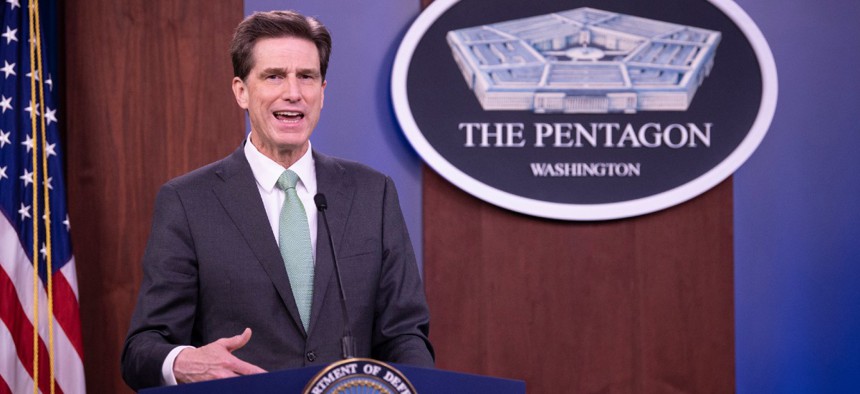
DOD CIO Dana Deasy speaks about the COVID-19 Telework Readiness Task Force on April 13 in the Pentagon Briefing Room. Marv Lynchard/Defense Department
Pentagon Aims to Support More Sensitive Telework By Year's End
The Defense Department is also in “an active conversation” about sustaining telework post-pandemic, according to Chief Information Officer Dana Deasy.
The next step for a cloud-based collaboration tool the Defense Department built to facilitate personnel working from home during the pandemic is to run pilot programs that allow remote access to information with higher levels of sensitivity, Defence Chief Information Officer Dana Deasy said.
“There’s a lot of pilots going on right now on how we pivot [the Commercial Virtual Remote Environment] from an [impact level] 2 world to an [impact level] 5 world between now and, I’m going to say toward the end of this year,” he said.
The Commercial Virtual Remote Environment, or CVR, was created in conjunction with Microsoft Teams and supports nearly a million workers using functions such as chat and video to meet and collaborate. It’s a point of pride for Deasy, who said it would normally take a year to set up the system that was operational in 60 days due to cloud technology. He provided an update on the CVR and other elements of the department’s digital modernization effort in a press briefing Thursday.
“I’ve often talked about building the enterprise cloud as the foundation of digital modernization. Cloud has always been much more than JEDI,” Deasy said. The Joint Enterprise Defense Infrastructure, a contract for such cloud services, has been long delayed due to a legal battle between the department, Amazon and Microsoft.
Barring any unforeseen additional issues, Deasy said the department is on schedule to do a “re-announcement” of the intended JEDI award toward the end of August.
He highlighted the recently designated Enterprise DevSecOps Initiative being led by the Air Force as evidence that “DOD was always going to be a multi-cloud environment.”
Regarding CVR, Deasy called the effort “an unclassified version of collaboration” and noted that the idea was always there to move it to an environment capable of supporting more secure types of collaboration. “The trick in doing that is you don’t want to lose the goodness of how we’ve been able to allow people to work off-net, so to speak, from their home, from their own types of devices,” he said.
For employees already able to use CVR, the benefits may stick around beyond the pandemic. Deasy said there is “an active conversation” about sustaining telework into the future, in part to reap cost savings from not having to maintain physical office space.
“We’ve now built this amazing robust infrastructure so there’s no doubt that we’re going to be able to leverage that in the event that the future requires us to,” he said, “but I believe personally that we’ll be leveraging that … around cost savings as well.”
Deasy told reporters the department currently doesn’t need any additional funding from Congress to facilitate remote work as the pandemic drags on.
“The environment we’ve created today is meeting the needs of the Department of Defense, not only from the warfighting and readiness standpoint, but from the teleworking standpoint as well,” he said. “The future is unpredictable but the money we’ve received to date has adequately allowed us to build out the necessary teleworking environment.”


